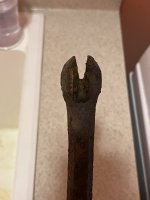- May 20, 2004
- 1,721
- 152
- Detector(s) used
- Minelab Excal 1000
- Primary Interest:
- All Treasure Hunting
Florida's stolen artefacts
Feb 15th 2007 | TAMPA
From The Economist print edition
An open invitation to make a little money
THE archaeological site in Thonotosassa, which means “land of flint” in the Seminole-Creek language, is nothing much to look at: a few pits dug in the sandy soil among gnarled live oak trees, with cattle grazing round. No one guards it. Yet this place, about 17 miles (27km) north-east of Tampa, is a good spot to find Indian artefacts, on high ground close to fresh water. Robert Austin, an archaeologist who has dug there often, says that some of the remains discovered date back 12,000 years.
The chance of finding ancient objects draws thieves, too, to dig for arrowheads, flints and pots. A good arrowhead can fetch thousands of dollars. Trespassers usually scout the scene of the would-be crime during daylight hours, then return with shovels at night. No one stops them.
Last month five men were arrested at Thonotosassa on suspicion of intending to loot it. They said they were collectors, and had no intention of selling the arrowheads they were looking for. They have now been charged with trespassing.
The problem is not confined to one area of the country, or even to the open air; 26 bowls and bottles of the Caddo Nation, about 600 years old, were stolen from Southern Arkansas University in August 2006. But lack of security at Indian archaeological sites makes them particularly vulnerable.
Bureaucratic tangles don't help. The Bureau of Indian Affairs gets involved only if the theft is from federal land. Sometimes local police will investigate stealing and trespassing; sometimes it is left to tribal law enforcement. Depending on who owns the land, the Bureau of Land Management, the Forest Service, the National Park Service or state wildlife commissions may all have jurisdiction. The result is often that no one takes action at all.
“We treat it as a serious crime. It's a unique kind of crime that does irreparable damage,” says Wayne Dance, the assistant US attorney in Salt Lake City, who has obtained 41 convictions in archaeological-theft cases in the past 14 years. Thefts from ancient Indian ruins, he adds, are a growing business in the Four Corners area, where Utah, Colorado, Arizona and New Mexico meet in spectacular mountains.
“The only way to solve this problem”, says Mr Austin, “is to educate the public about why it's wrong to salvage these sites. The problem is, these sites are getting destroyed faster than we can educate.”
http://www.economist.com/world/na/displaystory.cfm?story_id=8711428
Feb 15th 2007 | TAMPA
From The Economist print edition
An open invitation to make a little money
THE archaeological site in Thonotosassa, which means “land of flint” in the Seminole-Creek language, is nothing much to look at: a few pits dug in the sandy soil among gnarled live oak trees, with cattle grazing round. No one guards it. Yet this place, about 17 miles (27km) north-east of Tampa, is a good spot to find Indian artefacts, on high ground close to fresh water. Robert Austin, an archaeologist who has dug there often, says that some of the remains discovered date back 12,000 years.
The chance of finding ancient objects draws thieves, too, to dig for arrowheads, flints and pots. A good arrowhead can fetch thousands of dollars. Trespassers usually scout the scene of the would-be crime during daylight hours, then return with shovels at night. No one stops them.
Last month five men were arrested at Thonotosassa on suspicion of intending to loot it. They said they were collectors, and had no intention of selling the arrowheads they were looking for. They have now been charged with trespassing.
The problem is not confined to one area of the country, or even to the open air; 26 bowls and bottles of the Caddo Nation, about 600 years old, were stolen from Southern Arkansas University in August 2006. But lack of security at Indian archaeological sites makes them particularly vulnerable.
Bureaucratic tangles don't help. The Bureau of Indian Affairs gets involved only if the theft is from federal land. Sometimes local police will investigate stealing and trespassing; sometimes it is left to tribal law enforcement. Depending on who owns the land, the Bureau of Land Management, the Forest Service, the National Park Service or state wildlife commissions may all have jurisdiction. The result is often that no one takes action at all.
“We treat it as a serious crime. It's a unique kind of crime that does irreparable damage,” says Wayne Dance, the assistant US attorney in Salt Lake City, who has obtained 41 convictions in archaeological-theft cases in the past 14 years. Thefts from ancient Indian ruins, he adds, are a growing business in the Four Corners area, where Utah, Colorado, Arizona and New Mexico meet in spectacular mountains.
“The only way to solve this problem”, says Mr Austin, “is to educate the public about why it's wrong to salvage these sites. The problem is, these sites are getting destroyed faster than we can educate.”
http://www.economist.com/world/na/displaystory.cfm?story_id=8711428




